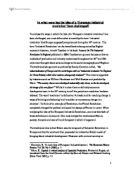To what extent did the idea of a separate sphere(TM) of life for women become eroded in the period 1870-1914?
To what extent did the idea of a ‘separate sphere’ of life for women become eroded in the period 1870-1914?
In her review of six different historical texts on 'separate spheres', Judith Lewis astutely remarked: 'one gets a healthy sense...that historians have been far more bamboozled by Victorian propaganda than the Victorians were.' Indeed, 'proponents of...[the]...feminine ideal...for instance, Tennyson's “The Princess”...[and]...Coventry Patmore's 'Angel in the House' were certainly part of – and also inspired – the contemporary prescriptive literature. As a result, the stereotype of the domestically imprisoned woman prevails, and 'separate sphere' has become an orthodox term in the study of female history. It is important to examine how far these ideals were followed. As K.D. Reynolds pointed out, 'this...version of femininity...ascrib[ed] to the least desirable qualities of the gender – frivolity, lack of application, corruptibility, frailty...and sexual weakness' thus making it seemingly impractical, not only for the poorer middle and lower classes whom most likely could not afford such an inefficient member of the family, but in (theoretically) the introduction of women into the public sphere (another concept to be later examined). What must be remembered, however, is that 'separate spheres' is a historical rather than a contemporary term. In other words, it is an instrument invented by historians for historians for the specific purpose of attempting to understand this complex and controversial strand of history, thus we must focus not so much on the actual term but what the term covers. It is only then that definitive factors, such as marriage legislation and employment, can be properly contextualised and understood, and the underlying concept appropriately analysed.
The most obvious factor behind 'separate spheres' is difference. Having cross referenced a number of historical texts, there are two texts in particular that stand out, and unsurprisingly they contradict each other. In Ruth Adam's 'A Woman's Place 1910-1975', she interprets this difference in terms of men and women's roles. We can infer from her text that there was no such thing as two different worlds as there was only one world and that was 'a man's world'. She observed that 'all the colour and romance of having an Empire – the beautiful uniforms which made the women look drab as peahens in comparison...belonged to the men.' Jose Harris, on the other hand, takes a more literal approach to 'separate spheres' and theorised in 'Private Lives, Public Spirit: Britain 1870-1914' that men and women had their own respective worlds. She stated that 'even...when the legal predominance of fathers of fathers was indisputable...Taine [a visiting French critic] in 1871 was struck not by the moral supremacy of English fathers but by the high proportion of Englishmen whose “sole contribution to family life [was] money”, leaving all real decisions...to their wives.' In other words,Harris implies that the family was one of the worlds which belonged to women and not the men, who were too busy participating in the 'late Victorian cult of...'clubland' [which] was an almost exclusively, and often aggressively, masculine sphere.' Arguably, Adam's text focuses on the period 1910-1914, and Harris' the late Victorian era which could already suggest an evolving (if not eroding) idea of 'separate spheres'. Indeed, Harris summarises 'the last quarter of the nineteenth century [as] a period of continuous and quite seminal, if partially invisible, change in the perception of women's roles and in the realignment of male-female relationships.' Perception is a key word here. It could well be that the underlying root of 'separate spheres' is the stereotype of the passive female. Although it is very difficult – albeit impossible – to appropriately and accurately measure the true passivity of women, evidence shows that even as early as 1870 and before, women were not necessarily shrinking violets. 'Martin Pugh has indicated a number of cases...where the wife was the guiding partner (notably Theresa, marchioness of Londonderry, and Margaret, countess of Jersey)'. However, the point is 'such dominance was not necessarily strident or openly displayed' and ladies 'paid...lip-service to formal subservience in order to spare their husband's flimsy egos.'. Having examined a few of many concepts of 'separate spheres' we are now left with at least three conflicting possibilities. Would the erosion of the idea of 'separate spheres' mean the woman would no longer need to feign passivity and would be regarded as her husband's equal? Would this erosion leave the expectation of female subservience in place, yet allow the women access to the 'aggressive masculine sphere' of 'clubland'? Or, would erosion of the idea of a 'separate sphere' require Adam's realistic but somewhat pessimistic notion that the world remained adversely masculine, but by 1914 the women had empowered themselves enough to potentially enjoy the same privileges as men (but with greater difficulty)? All three possibilities are to a greater or lesser extent radically ambitious for a short period of 44 years, and even having concocted three hypotheses, the 'separate spheres' notion seems rather vague and inadequately explored. However, as mentioned before, 'separate spheres' is merely an invented historical term, thus it is the underlying concepts that matter. What we can do is examine the effects of landmark change and determine the extent to which change has occurred in regards to the perception of women and the amount of power a woman could exercise.

This is a preview of the whole essay
Teacher Reviews
Here's what a teacher thought of this essay
This essay is well written and well structured, and explores several interesting themes well. The student is clearly familiar with the historiography on the topic and uses it well, although a wider range of references would be helpful in places. It would also be useful to consider whether the experience of separate spheres varied by class, region or occupation. 4 stars.








